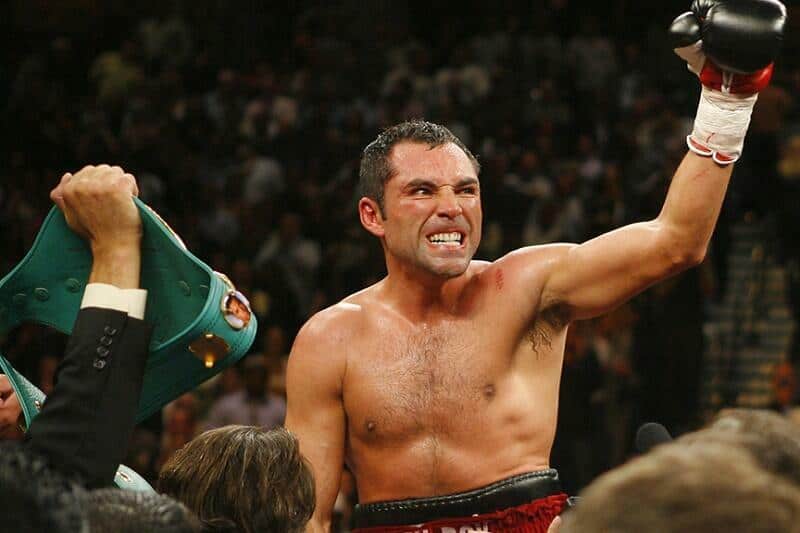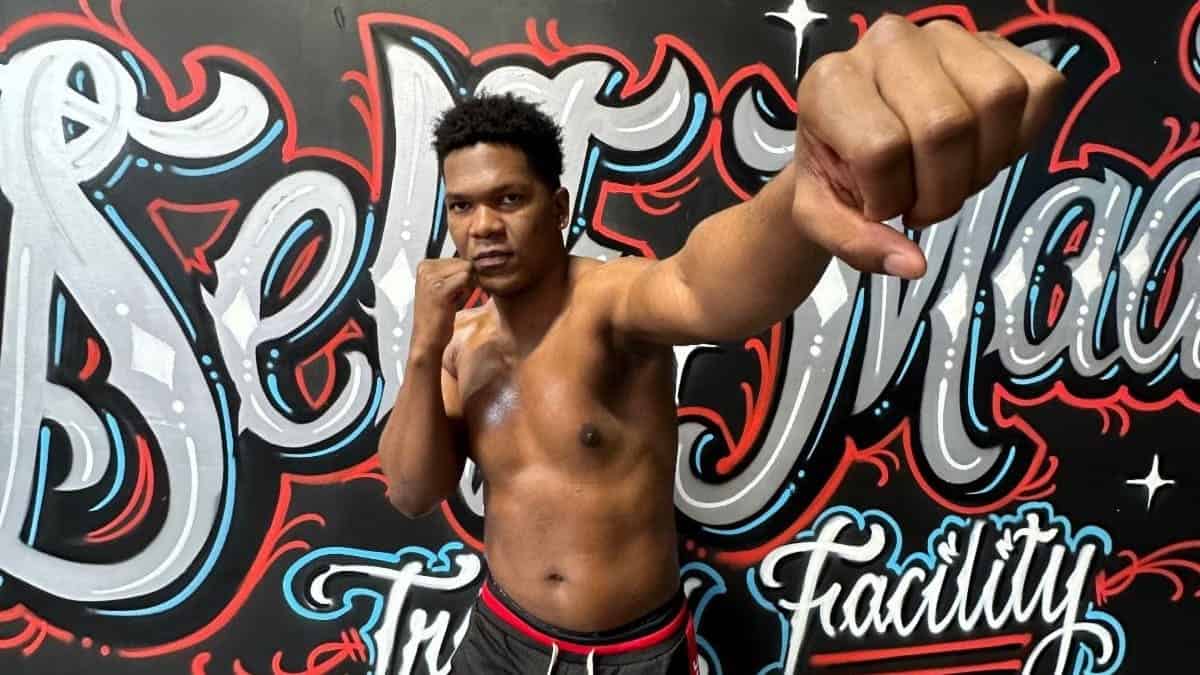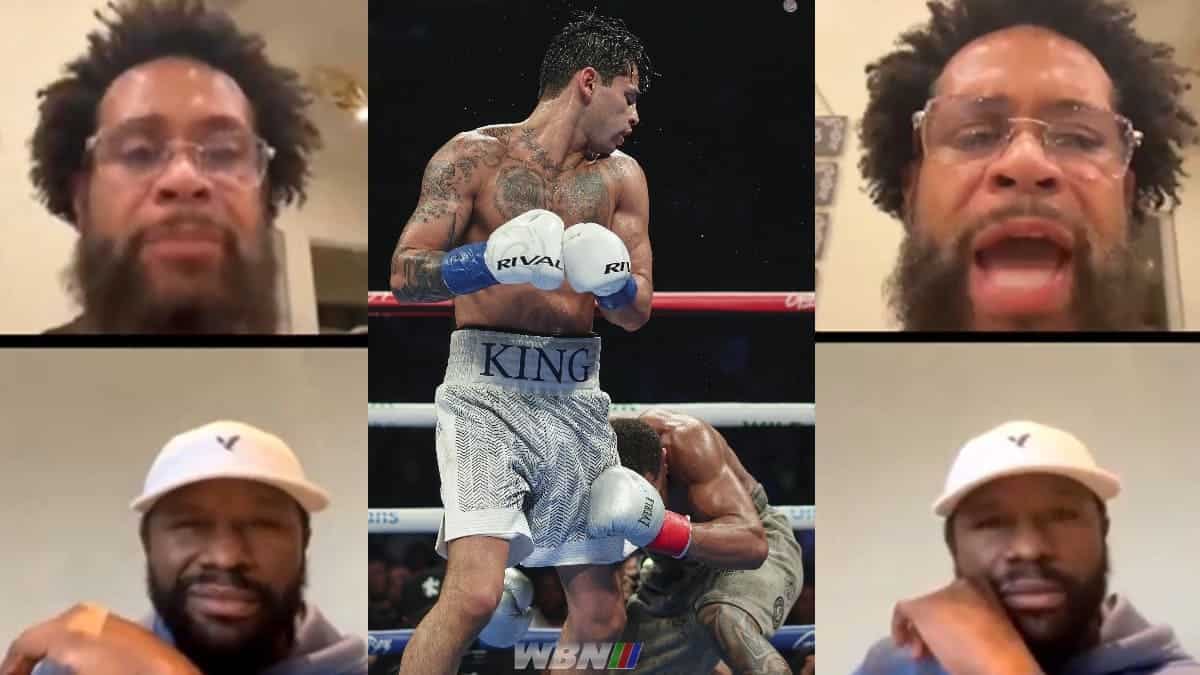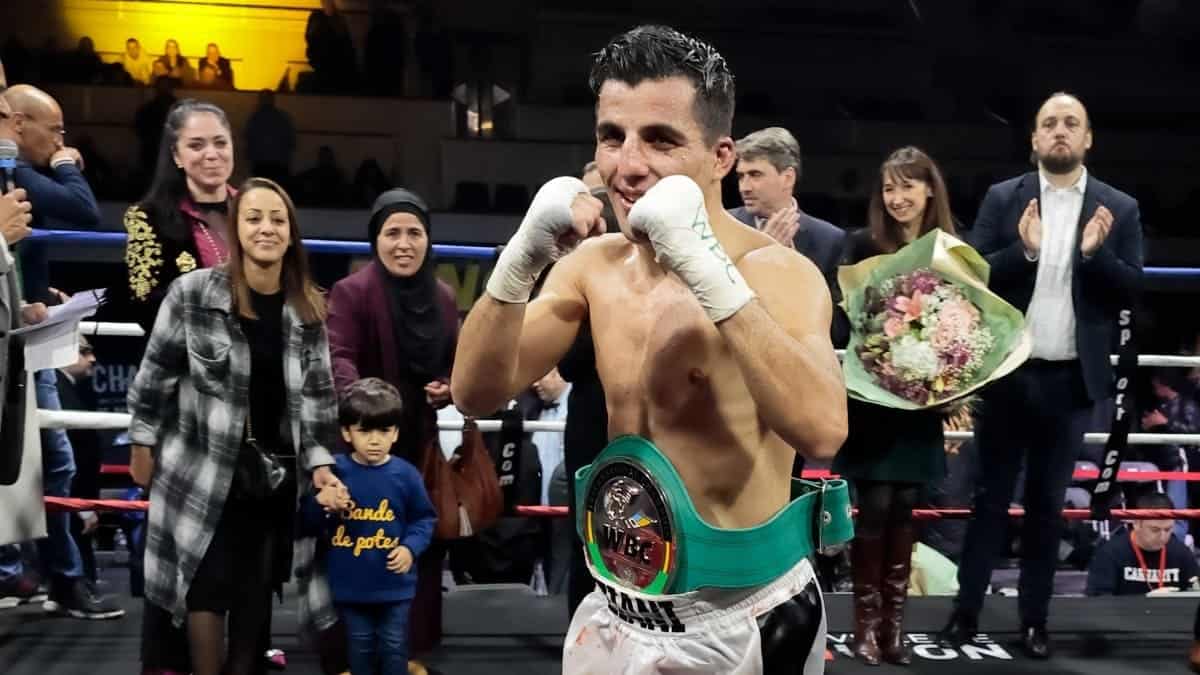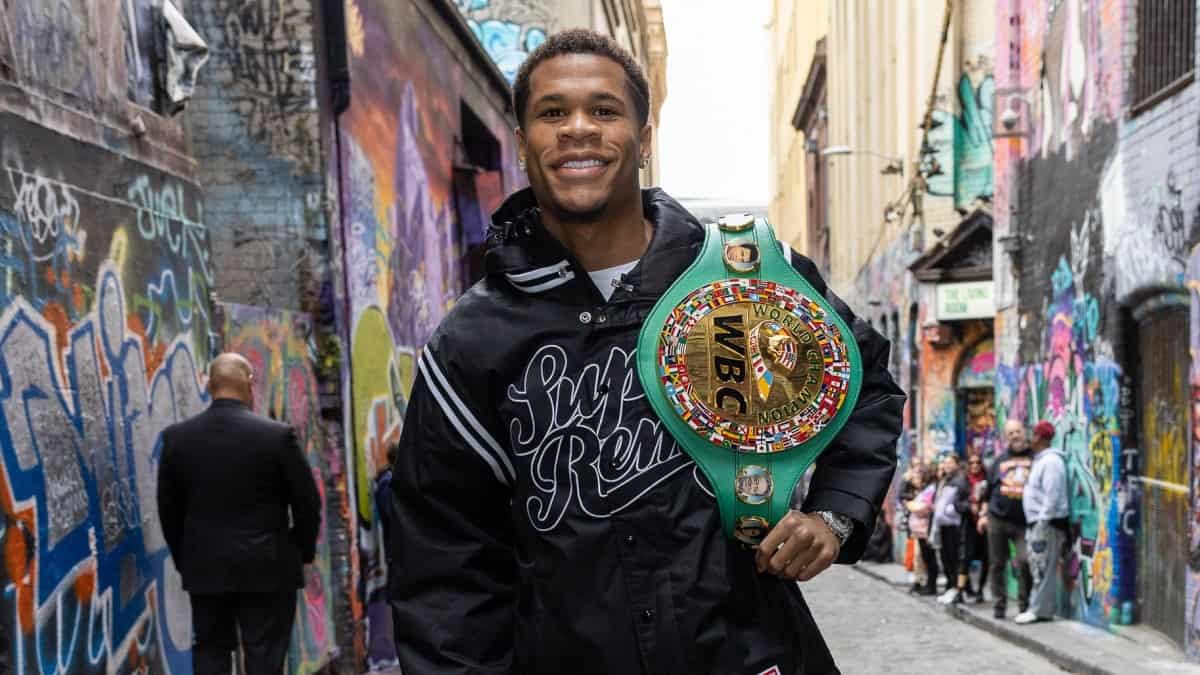Beginning at a young age, Oscar De La Hoya had over two hundred amateur fights. The youngster lost just a handful of bouts before claiming the 1989 National Golden Gloves Bantamweight Title.
In 1991, he was U.S Amateur boxer of the year. A year later, he qualified for the 1992 Olympics in Barcelona.
De La Hoya duly returned to the U.S with the Gold medal around his neck and earned himself a nickname; ‘The Golden Boy.’
Within two months, Oscar had his first professional contest lined up. Wasting no energy, he knocked out Lamar Williams with only one minute forty-two seconds on the timekeeper’s clock.
De La Hoya followed up his maiden victory with ten knockouts in his next eleven bouts. In just his 12th fight, most of them being at lightweight, he was offered the chance to drop down a weight and fight for his first world title.
Unbeaten fighter Jimmy Bredahl stood in his way of destiny. Bredahl was making his second defense of the WBO super-featherweight title he’d claimed two years previously.
The fight took place on Oscar’s home soil in California on March 5th, 1994. In front of a cheering home crowd, De La Hoya out-boxed the Danish southpaw.
De La Hoya scored a tenth-round technical knockout and claimed the coveted belt at just 21.
LAS VEGAS
De La Hoya would defend the title just once, two months later, in the city which would ultimately become his boxing home, Las Vegas. On the undercard of a Roy Jones Jr. title defense, De La Hoya quickly knocked out Giorgio Campanella.
After Campanella, he enhanced his weight. De La Hoya would then take on Jorge Paez for the lightweight version of his WBO title.
Four months after claiming the super-featherweight version, he overwhelmed the experienced ex-featherweight ruler. De La Hoya picked up his second world title with a second-round KO.
Two knockout defenses followed in 1994 before De La Hoya easily out-pointed John Molina at the MGM Grand. This scenario led him into a unification battle with IBF lightweight champion Rafael Ruelas.
At 24, Ruelas had an impressive 43 wins from his 44 contests. The Jalisco man was making the third defense of the title he took from Freddie Pendleton a year earlier.
De La Hoya was again at his ruthless best, knocking out Ruelas within two rounds to claim the third world title of his career in only his 18th fight as a professional.
At this point, the signs of greatness were already evident in De La Hoya. Even at a relatively tender age. The whole of America had seemingly warmed to the young skinny kid with a bright smile and the movie star’s good looks.
Continuing his career and sensing more accolades, Oscar would immediately give up the IBF version of his title. He would instead make two defenses of his WBO Title in 1995. One was an incredible second-round knockout of Jesse James Leija at Madison Square Garden.
CHAVEZ
A routine stoppage of Darryl Tyson in a February 1996 non-title contest brought about a weight class jump: going face-to-face with his childhood idol was on the cards. De La Hoya would battle WBC light-welterweight champion and all-around Mexican legend Julio Cesar Chavez at Caesars Palace in April.
Chavez was a Mexican national hero, with only one loss in 98 bouts. Not to mention Chavez had five world titles behind him and bags of guile with abundant experience.
The 34-year-old superstar was supposed to be the toughest test of De La Hoya’s career.
De La Hoya came into the ring with a Mexican flag on his shorts. But due to his 1992 Olympic Gold Medal for the USA, the Mexicans were all for Chavez. Some even took it upon themselves to boo the new American idol.
Many people believe the fight should never have taken place in the first place stemming from Oscar’s own double nationality connections. But it did, and De La Hoya came out on top in a pulverizing four-round performance. Proving beyond doubt, he was at the peak of his powers. Chavez, in contrast, was maybe at the end of his.
Oscar had too much speed and power for the one-time ‘unbeatable’ Chavez. And after the doctor took a look at his blood-stained face, referee Joe Cortez waved the fight off to crown Oscar the winner. He added the WBC title at 140lbs to his growing belt collection.
GONZALEZ
Miguel Angel Gonzalez was the next challenger to De La Hoya’s crown, as it happened another Mexican. Gonzalez was unbeaten in 41 contests and a former WBC lightweight title-holder.
Every weight Oscar moved up seemed to make him bigger and stronger. The extra five pounds almost added an extra layer of muscle to De La Hoya, which must have unnerved his opponents.
Gonzalez proved a real demanding customer, though. He took Oscar the distance for only the second time in his career, even though the judges handed out an easy points victory and a 23rd career win.
WHITAKER
Oscar was taking on all comers by now, moving up the weights again to face one of the best pound-for-pound fighters in the world in 1997 – Pernell Whitaker.
Whitaker had only lost once in a contentious split decision. ‘Sweet Pea’ was also the first man to stop Julio Cesar Chavez from winning a fight at the height of his powers.
The American had also held some form of a world title for over eight years. Pre-fight predictions expected Whitaker to push De La Hoya all the way.
Another tough twelve rounder ensued, although De La Hoya had matured so much he could pick an opponent apart round by round. This enhancement enabled him to get points in the bag, as he did with Whitaker when gaining a unanimous triumph.
Winning his fifth world title in a fourth different weight division, it was clear that the man was remarkable. He proved it again just two months later by knocking out David Kamau in two rounds. A man who had lost just once in 29 contests and never taken out.
Whatever the weight, whoever the opponent, Oscar seemed to know a way around his challengers. He had the boxing brain, the skills, and the devastating power to go with it. All this made for an outstandingly gifted fighter.
CHAVEZ II
By the back end of 1997, De La Hoya seemed settled at welterweight. After the Kamau knockout, he made another six defenses, beating a 35-year-old Hector Camacho and an unbeaten Ike Quartey. He followed that up by defeating an over-the-hill Julio Cesar Chavez in an unnecessary rematch four years after their first meeting.
One year on, De La Hoya had the opportunity to add a sixth world title to his haul against undefeated knockout specialist Felix Trinidad at the Mandalay Bay Casino in Las Vegas.
It was the biggest pay-per-view event for a non-heavyweight contest at the time. After twelve pulsating rounds, Trinidad took a majority decision to inflict De La Hoya’s first professional defeat in his seven-year career.
Fans clambered for a rematch between the two fighters. But after a five-month break, Oscar decided on a warm-up bout first. Easily defeating Derrell Colley (34-1-2) for the lowly regarded IBA welterweight title via a seventh-round KO, De La Hoya was once again ready for Trinidad. It sadly wasn’t meant to be.
Before De La Hoya’s victory over Colley, Trinidad had shockingly decided to move up to light-middleweight to challenge David Reid for his WBA Title, scuppering any chance of a highly anticipated rematch between the pair.
Oscar agreed on a deal with undefeated former IBF lightweight champion “Sugar” Shane Mosley in a welterweight super-fight for the WBC title.
Whether the Trinidad loss had affected his confidence or the preparation wasn’t proper are both hypothetical theories for the outcome. Oscar shockingly lost for the second time – again on points.
GATTI
De La Hoya moved on. He’d already battled the rugged Arturo Gatti before the Mosley contest went ahead. Both sets of fans wanted to see the fight regardless of title involvement.
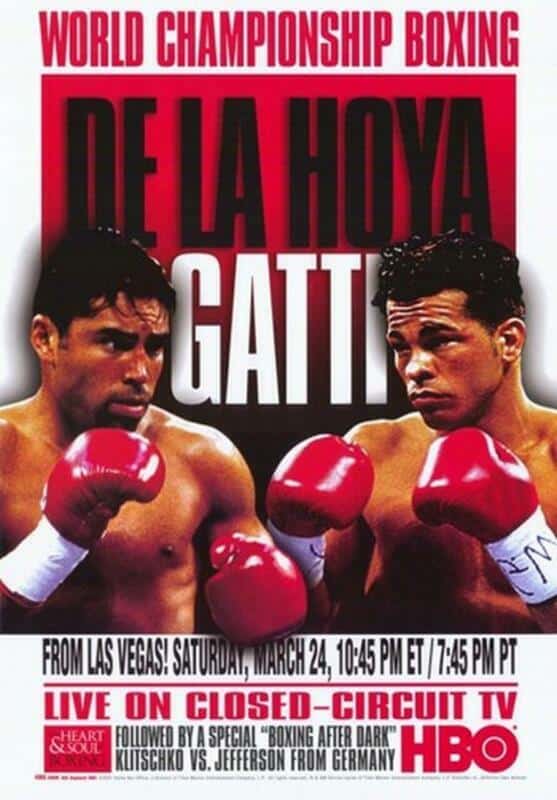
Oscar went ahead with the Gatti encounter planning a move up to light-middleweight immediately afterward.
Due to holding too much overall brute strength for the former super-featherweight champion, De La Hoya beat an out-of-depth Gatti via a fifth-round TKO.
It was Gatti’s penultimate fight before his legacy-sealing trilogy with Mickey Ward.
Around this time, Oscar decided to look at a career outside of boxing and announced the formation of ‘Golden Boy Promotions.’ A venture where he would now promote his fights along with other boxers. To take some of the slack, he enlisted the help of Richard Schaefer as his right-hand man and CEO.
True to his word after the Gatti fight, Oscar moved up to light-middleweight to challenge Javier Castillejo for the WBC title in June 2001. Once again, De La Hoya found a home at the MGM Grand. Dominating the Spaniard to take his title, a now 28 year-old De La Hoya won by a landslide points margin for another strap.
It meant a seventh world title in five weight divisions was in the bag for the Golden Boy.
VARGAS
De La Hoya would now face an old amateur foe for his next challenge as a unification fight with WBA Champion Fernando Vargas was in talks.
Their rivalry dated back years, and even though De La Hoya had initially said he would not fight Vargas, he finally signed the contract for early 2002.
Nicknamed ‘Bad Blood,’ the title said it all. But the rivalry would only intensify as Vargas got forced to pull out of the first scheduled meeting with a hand injury. The postponement meant that by the time the fight went ahead in September 2002, Oscar hadn’t fought since June 2001.
The days of Oscar dominating his opponents had now gone. ‘The Golden Boy’ had found his level, and any champion over 147lbs would be a stern test for him. Vargas did not disappoint, taking Oscar long before succumbing to his power in the eleventh round.
An eighth world title for De La Hoya was a fantastic achievement. After the fight, even a Vargas positive drugs test couldn’t take the shine off Oscar’s achievement.
Eight months later, he would return to the ring. Oscar knocked out an aging Luis Ramon Campos in May 2003. It was then a rematch with one of only two men to have defeated him.
MOSLEY II
Shane Mosley II got penciled in for September 2003 at the MGM Grand.
De La Hoya had a perfect 6-0 record when fighting at the MGM Grand and was confident of avenging his defeat to ‘Sugar’ Shane three years earlier.
Even though De La Hoya threw more punches than Mosley, it was once again his boogeyman opponent who came out on top. In the process, Mosley took the WBC light-middleweight title with him.
Oscar immediately moved up to middleweight, 31 and one quarter pounds heavier than his first world title victory. Focusing his attention on the unbeaten WBO middleweight champion Felix Sturm. The German got looked at as one of the weakest of the 160lb champions.
With a game plan in mind, though, De La Hoya hoped for a money-spinning super-fight with unified champion Bernard ‘The Executioner’ Hopkins. At the time, Hopkins was the pound-for-pound king after an astonishing run at middleweight.
Oscar knew he’d need a title to make the fight happen as ‘B-Hop’ held three middleweight belts (WBC, IBF, and WBA). Targeting Sturm’s WBO Title was the perfect tactic to secure a Pay-Per-View blockbuster.
Making De La Hoya look aged and wilted at times, Sturm pushed the multi-weight ruler as the pre-fight favorite struggled to out-work the hungrier champion.
In controversial circumstances, De La Hoya somehow got the decision. In the process, he picked up Sturm’s crown. Judges saw it 115-113 on all three cards in favor of Oscar, while most journalists at ringside had Sturm winning the fight.
HOPKINS
If somewhat contentiously, Oscar’s ninth world title in six weight divisions hit the record books. A mega match-up with Hopkins was then able to be penciled in for September 2004, just three months later.
Hopkins was a big, strong middleweight. Therefore, the bout got agreed at a catch-weight of 156lbs.
As usual, the MGM Grand hosted as De La Hoya headed back to the scene of his infamous defeat to Mosley twelve months before.
Interest in the fight was immense. Both competitors stood to earn a staggering $30 million on the night. With an array of Hollywood stars ringside, hundreds of millions of people watched on TV.
SIZE
Many people saw Hopkins’ size advantage as the deciding factor. It proved to be the case as De La Hoya took a body shot in the ninth round, ending his unification hopes after a reasonably one-sided battle.
Reassessing his situation, Oscar took almost two years out of the ring in what proved to be a semi-retirement. He then signed on to fight Ricardo Mayorga in an attempt to win back the WBC light-middleweight belt he held between 2001 and 2003.
Mayorga showed De La Hoya a complete lack of respect in the build-up to what eventually turned out to be a full-blown grudge match. The bout took place in May 2006. With insults about his wife ringing if his ears, Oscar pounded Mayorga to the floor in the first round. He finished off the Nicaraguan with a sixth-round onslaught.
The win for Oscar meant an extraordinary tenth world title in six different weight divisions. It was simply adding one more layer of gloss to an already extensive legacy for the Olympic champion.
MAYWEATHER
Oscar would revel in his victory for around nine months before a confident Floyd Mayweather Jr. decided to move up from welterweight and challenge him.
Accepting the offer, De La Hoya appeared opposite Mayweather in a clash branded ‘The World Awaits.’ The PPV took place on May 5th, 2007.
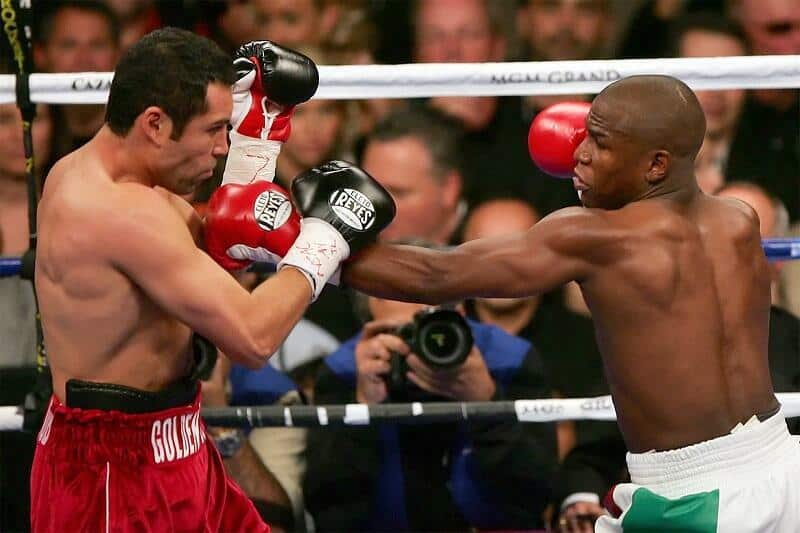
It would be yet another fight against a man considered the best pound-for-pound fighter. De La Hoya rolled back the years at times in an impressive showing. Ultimately, he would come up short against the undefeated ‘Pretty Boy’ – losing on a split decision despite pressing Mayweather for the complete twelve rounds.
Another nine-month absence followed before the lure of the ring had him back in training. A collision with blown-up super-featherweight Steve ‘2 pounds’ Forbes hit the table at a catch-weight of 150lbs.
The fight was a highly winnable affair that could lead to something bigger.
There was no title on the line, but Oscar completely out-classed the smaller Forbes to take a unanimous decision. He won nearly every round on all three judges’ scorecards.
PACQUIAO
It would be an ideal warm-up fight to build confidence back up. WBC lightweight champion Manny Pacquiao was lying in wait just around the corner.
Pacquiao v De La Hoya was secured for December 2008. A non-title fight at catch-weight of 145lbs.
Many people doubted whether De La Hoya still had the tools to go with his desire at 35. As Pacquiao had moved up from flyweight over nine years, some thought Oscar’s power could still be a telling factor.
Pacquiao showed unbelievable strength on the night. ‘Pacman’ cemented himself as one of the pound-for-pound best in the world by stopping Oscar on his stool in the eighth round. It was a dominant win for Pacquiao, and the writing was on the wall for De La Hoya from that point.
Looking like a shadow of his former self, De La Hoya was physically taken apart by the Filipino boxer, a five-weight world champion. Pacquiao was at the peak of his powers, whereas Oscar was at the end of the road.
After winning ten world titles in six different weights, Oscar De La Hoya officially retired from professional boxing on April 14th, 2009.
OSCAR DE LA HOYA TITLES
World Boxing Organization super-featherweight champion (1994)
WBO lightweight champion (1994-1995)
International Boxing Federation lightweight champion (1995)
World Boxing Council light-welterweight champion (1996-1997)
WBC welterweight champion (1997-2000)
WBC light-middleweight champion (2001-2003)
World Boxing Association light-middleweight champion (2002-2003)
WBO middleweight champion (2004)
WBC light-middleweight champion (2006-2007)
*IBA not counted
To this day, Oscar’s company, Golden Boy Promotions, remains a significant player in boxing.
WBN Editor Phil has over ten years of boxing news experience. Follow WBN us on Twitter @WorldBoxingNews.

